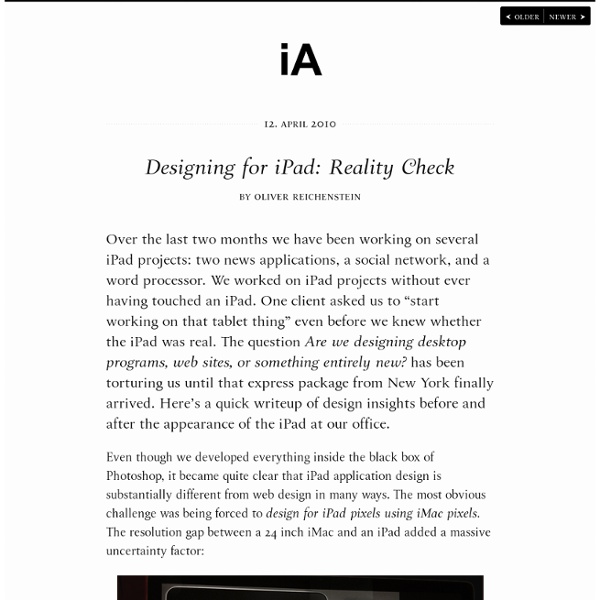for iPad is here!
Two months ago, we sat glued to our browsers as details of the iPad started streaming out of Apple’s launch event. It didn’t take us very long to formulate our official strategy for the new device: we were going to support the hell out of it, and we had 60 days to do it. Today is iPad launch day and as long lines start to form outside of Apple stores and UPS-Santa makes his rounds to sleepless geek households, we’re happy to say that Evernote for the iPad is live in the Apple AppStore! The new Evernote version (3.3) for Apple’s mobile devices is a universal binary that will run on all iPhone, iPod Touch and iPad devices. There aren’t many changes for iPhone / iPod Touch users in this version, but if you run it on an iPad you get a completely new user experience. Something to hold Designing the new interface was a daunting task. What should it be? We tried taking our existing iPhone UI and making it bigger. Things to try Views Scroll through all your notes in the “All notes” screen. Places
Mac OS X Human Interface Guidelines: About the Guidelines for Creating Great Mac OS X Apps
Mac OS X Human Interface Guidelines describes the characteristics of the OS X platform and the guidelines and principles that help you design an outstanding user interface and user experience for your Mac app. Mac OS X Human Interface Guidelines does not describe how to implement your designs in code. When you’re ready to code, start by reading Mac App Programming Guide. At a Glance Aqua is the overall appearance and behavior of OS X. Interface Builder (a graphical UI editor in Xcode) is the best way to begin building an Aqua-compliant user interface. Great Apps Begin with an Understanding of the Fundamentals Before you begin designing your app, you need to get a feel for the OS X environment. Most people are not acquainted with the principles of human interface design, but they can tell when apps follow the guidelines and when they don’t. People Expect a Great User Experience that Integrates OS X Technologies OS X users have high standards for the apps they run. How to Use This Document
iPad 2 - is it True
The condescending UI
I have a kneejerk reaction to most modern computer user interfaces (also, all microwave user interfaces). I've used plenty of excuses over the years: my "eye for design," my love of minimalism, a sense of utility. Today, I finally put my finger on it, and it's not just a desire for the-computer-as-pure-machine, or a spartan aesthetic. It's quite simple, really: I don't like the condescending tone. Growing up I was always very small for my age. I didn't mind the size ("the bigger they are, the harder they fall!" My problem with many modern UIs is that they never get past the telling phase. An example of this is the dramatic, quasi-utilitarian animated transition. But it's not just functionality, there's something deeper that bugs me, about the decorations themselves. And of course, there is the transgression of the century: Apple's downward spiral into overt 1:1 metaphors. For reference, here's where we started: Oh, how "far" we've come!
30 Useful iPad Apps for Business & Presentation
Apple sold more than 1 million copies of iPads in the first 3 months. This gadget is definitely more than just a larger version of iPhone or iPod touch. With 4x the screen of an iPhone, the iPad’s display is ideal for reading and for presentations. In today’s post, we’d like to highlight some really useful iPad applications that might replace the things you do daily with your laptop or netbook. With a piece of iPad and these applications, you probably don’t need to carry a laptop around. Here are 30 useful iPad applications for Business and Presentation you might find handy on your next project pitch or business trip. Full list after jump. Presentations KeynoteKeynote is the most powerful presentation app ever designed for a mobile device. CorkulousCorkulous is incredible idea board for iPad to collect, organize, and share your ideas that feel completely natural. Power Presenter This application is used for Presentation. Graph, Charts, Diagram & Statistic Planning Page & Documents Meetings
Cocoia Blog
All things iPod, iPhone, iPad and Beyond
Buddies Facebook Browser for iPad
55 Beautiful Apple iPad Wallpapers - Noupe Design Blog
May 31 2010 This is the age of iPhones, iPods and iPads, people simply love to have these amazing inventions of information technology. Apple iPhones have created a state of euphoria among its users with its amazing features and iPad is another product from Apple team that will let you browse internet, watch video, listen music, read books with just a finger touch. We are sure some of you have already purchased it and now want to customize it. Beautiful iPad Wallpapers LeopardDownload Wallpaper: 1024px × 1024px Calm Lake Download Wallpaper: 1024px × 1024px Wooden StyleDownload Wallpaper: 1024px × 1024px iPad Wallpaper 1364Download Wallpaper: 1024px × 1024px Closer To GodDownload Wallpaper: 1024px × 1024px Planet Earth Download Wallpaper: 1024px × 1024px Purple Plant CloseupDownload Wallpaper: 1024px × 1024px James Cameron’s Avatar iPad WallpaperDownload Wallpaper: 1024px × 1024px Clown Fish iPad WallpaperDownload Wallpaper: 1024px × 1024px Ocean of spot lightsDownload Wallpaper: 1024px × 1024px




Si vous n'avez qu'un seul article lire sur les enjeux de la conception sur iPad (notamment par rapport aux textes), c'est celui-ci ! by beolive May 2